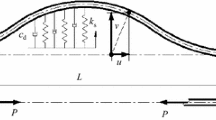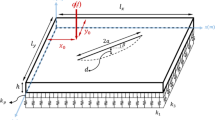Abstract
Fatigue crack growth in resonating members of distributed mass is studied under conditions of dynamic interaction between crack growth and crack load. The crack propagation rate is related to the stress intensity facfor range by way of the well known power law. The depth of the crack determines the local flexibility due to crack which in turn influences the dynamic response of the system under an external force with constant amplitude and frequency. The propagating crack introduces additional flexibility to the continuous system which results in gradual shifting away of the resonance which results in smaller loading of the cracked section. This reduces, in general, the growth rate and brings eventually the system to a value of crack propagation rate below a conventional threshold rate which can be interpreted as dynamic crack arrest. It is important from an engineering standpoint to know the total crack growth at that time which determines the component structural integrity.
Material damping is introduced through the use of complex modulus of elasticity and determines absolutely the crack growth rate in resonance, assuming that material damping is the dominant damping mechanism of the system.
Résumé
On étudie la croissance de fissures de fatigue dans des composants en résonnance comportant des masses distribuées, sous des conditions d'interaction dynamique entre la croissance de la fissure et la charge qui entretient celle-ci. La vitesse de propagation de fissuration est liée à la variation du facteur d'intensité de contraintes par la relation parabolique bien connue. La profondeur de la fissure détermine la raideur locale associée à la fissure, laquelle influence à son tour la réponse dynamique du système sous une force extérieure présentant une amplitude et une fréquence constantes. La propagation de la fissure introduit un degré de liberté supplémentaire dans le système continu, qui a pour effet de s'écarter progressivement de l'état de résonnance avec, pour conséquence, une réduction de la sollicitation de la section fissurée. Ceci provoque en général une réduction de la vitesse de propagation, et conduit le système à un état où cette vitesse passe sous un seuil conventionnel, que l'on peut interpréter comme un seuil d'arrêt dynamique de la fissure. Il est essentiel du point de vue des calculs de connaître la croissance totale de la fissure à ce stade, puisqu'elle détermine l'intégrité strycturale du composant. En utilisan le module complexe d'élasticité, on introduit l'amortissement du matériau; celui-ci détermine la vitesse de croissance de la fissure en condition de résonnance, pour autant que l'on suppose qu'il soit le mécanisme dominant d'amortissement dans le système.
Similar content being viewed by others
References
P.C. Paris and F.A. Erdogan, Transactions of ASME, Journal of Basic Engineering 85 (1963) 528.
F. Erdogan, in Fracture, H. Liebowitz, ed., Vol. 2, Academic Press, New York (1968).
G.C. Sih, Engineering Fracture Mechanics 13 (1980) 439–451.
G.C. Sih, Engineering Fracture Mechanics 5 (1973) 365–377.
G.C. Sih, International Journal of Fracture 10 (1974) 305–321.
G.C. Sih and B. McDonald, Engineering Fracture Mechanics 6 (1974) 493–507.
A.D. Dimarogonas, Vibration Engineering, West Publishers, St. Paul (1976).
T.G. Chondros and A.D. Dimarogonas, Journal of Sound and Vibration 69 (1980) 531–538.
T.G. Chondros and A.D. Dimarogonas, Identification of Cracks in Circular Plates Welded at the Contour, ASME paper 79-DET-106, Design Engineering Technical Conference, ASME, St. Louis (dy1979).
A.D. Dimarogonas and G. Masouros, Engineering Fracture Mechanics 15 (1981) 439–444.
A.D. Dimarogonas and S. Paipetis, Rotor Dynamics, Applied Science Publishers (in press).
A.T. Stewart, Engineering Fracture Mechanics 13 (1980) 463–478.
V.M. Radhakrishnan, Engineering Fracture Mechanics 13 (1980) 129–141.
H. Tada, in The Stress Analysis of Cracks Handbook, Del Research Corporation, Hellertown, PA (1973) 2.13–2.14.
B.J. Lazan, Damping of Materials and Members in Structural Mechanics, Pergamon Press (1968).
J.R. Rice and N. Levy, Journal of Applied Mechanics (1972) 185.
Author information
Authors and Affiliations
Rights and permissions
About this article
Cite this article
Dentsoras, A.J., Dimarogonas, A.D. Resonance controlled fatigue crack propagation in a beam under longitudinal vibrations. Int J Fract 23, 15–22 (1983). https://doi.org/10.1007/BF00020154
Received:
Issue Date:
DOI: https://doi.org/10.1007/BF00020154




